The Featured Creatures collection provides in-depth profiles of insects, nematodes, arachnids, and other organisms relevant to Florida. These profiles are intended for the use of interested laypersons with some knowledge of biology as well as academic audiences.
Introduction
Leaf-gall thrips in the genus Gynaikothrips originating in southeast Asia infest Ficus. This is not a recent introduction. Specimens collected in Florida in 1887 are in the US National Museum (Denmark, 1967). Watson (1923) listed the genus in his key to thrips of North America. Two species, recognized as distinct by Priesner (1939) based only on differences in the length of the pronotal setae, are established in Florida: Gynaikothrips ficorum (Marchal) and Gynaikothrips uzeli (Zimmerman). However, whether or not they are distinct species is uncertain. Populations in Southeast Asia exhibit considerable variation in the lengths of the pronotal setae, and Mound et al. (1996) suggested that Gynaikothrips ficorum is probably a form of Gynaikothrips uzeli that has been spread by the horticultural trade. Gynaikothrips ficorum and Gynaikothrips uzeli are commonly called Cuban laurel thrips and weeping fig thrips, respectively.
Distribution
While most Gynaikothrips spp. are of Asian origin, species in this genus have been described from Africa. Gynaikothrips ficorum is pantropical, appearing wherever Ficus microcarpa L. f. is planted (Denmark 1967). It is recorded from Algeria, the Canary Islands, Colombia, Cuba, Dominican Republic, Guam, Taiwan, Ecuador, India, Java, Mexico, Nassau (Bahamas), Nicaragua, Israel, Palestine, Panama, Puerto Rico, El Salvador, Thailand, Spain, Sicily, and the United States. In the US, it is recorded from California, Florida, Hawaii, and Texas. Once it became established in Florida, Gynaikothrips uzeli was rapidly spread on Ficus benjamina L. originating from nurseries in southern Florida (Held et al. 2005). It has been reported from 10 states in the continental US: Hawaii, Puerto Rico, Trinidad, Mexico, Colombia, Argentina, and Costa Rica (Cabrera-Asencio et al. 2008; Held and Boyd 2008a; de Borbon and Agostini 2011).
Description
The life cycle takes about 30 days (Arthurs et al. 2011). Adults migrate to terminal leaves and establish folded-leaf galls within 2 to 3 days of infestation. Mating, egg laying, and a complete generation develop within a single gall. Adults exit galls within a few days of emergence, and migrate to new terminal leaves, either on the same or different terminal stem, to begin a new generation.
Egg
The egg is cylindrical with rounded ends, smooth, and is a translucent white.
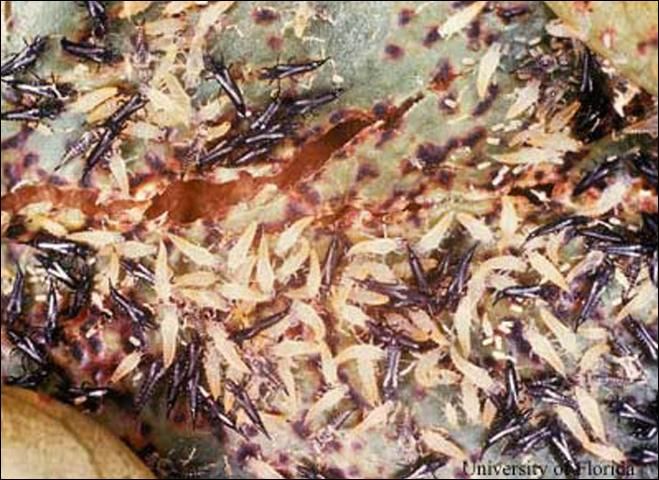
Credit: Paul M. Choate, UF/IFAS
Larva
There are two larval instars. The first instar is small and translucent white. The second instar is larger, light yellow and the posterior tube is dark and is held pointing up. The second instar is similar to the adult in size and shape. Both the first and second instars have red eyes.
Prepupa and Pupa
The prepupa has wing buds that are externally visible. The pupa has longer wing buds and the antennae are folded back over the head.
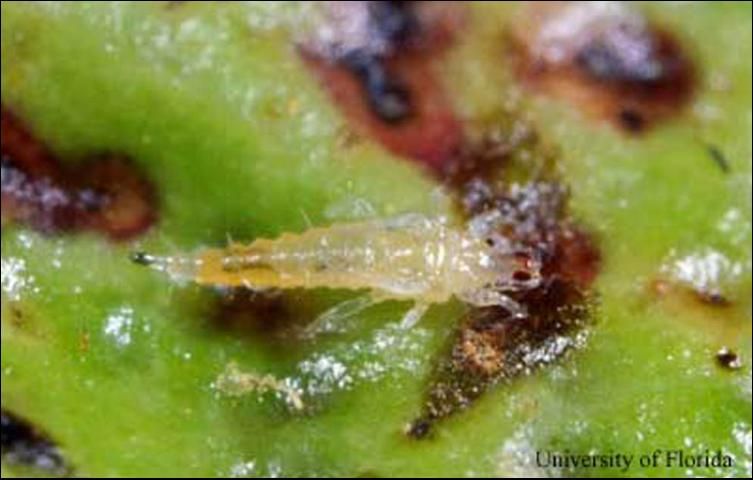
Credit: Paul M. Choate, UF/IFAS
Adult
The adult varies from about 2.6 mm to 3.6 mm in length and is dark yellowish-brown to black. With the exception of the legs and last abdominal segment, dorsal striations are shown on the adult. Breeding is continuous. Although the adult moves or flies rapidly when disturbed, it remains on or close to the leaves most of the time. They are also active flyers on hot days. Canizo (1945) and de Borbon and Agostini (2011) give detailed measurements of Gynaikothrips ficorum and Gynaikothrips uzeli, respectively.
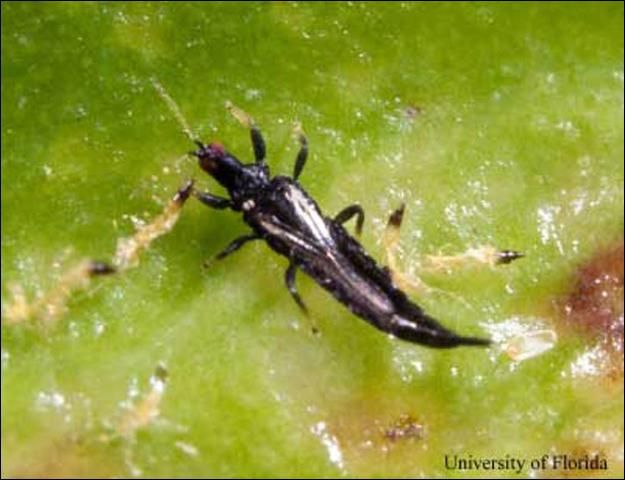
Credit: Paul M. Choate, UF/IFAS
Hosts
Chinese banyan, Ficus microcarpa L. (Urticales: Moraceae) is host for Gynaikothrips ficorum (Mound et al. 1996). Weeping fig, Ficus benjamina L., is host for Gynaikothrips uzeli (Arthurs et al. 2011). Wolcott (1953) says that most species of Ficus are largely or entirely immune to infestations, but when the thrips become abundant, they will feed on certain non-host plant species. Cuban laurel thrips are an occasional pest of orchids (Nixon 1999).
Refer to Hoddle et al. (2012) for more information on Gynaikothrips, including a key to the species of adult thrips. Key to eleven species of thrips.
Damage and Economic Importance
Adult thrips use their sucking mouthparts to feed on the tender, light-green leaves, causing sunken purplish-red spots. Feeding results in a specific, directed growth reaction that causes the leaf to roll, or the leaf may fold along the midrib. The curled leaf becomes tough as it yellows, sometimes dropping during rainy or windy weather. Leaves eventually drop from the plant prematurely. Infested trees will not be killed, but the ornamental value of the plant is reduced markedly. The thrips rarely are annoying but occasionally may bite people. Some countries restrict the importation of plant material intercepted at ports-of-entry when they are infested with Gynaikothrips ficorum or Gynaikothrips uzeli.
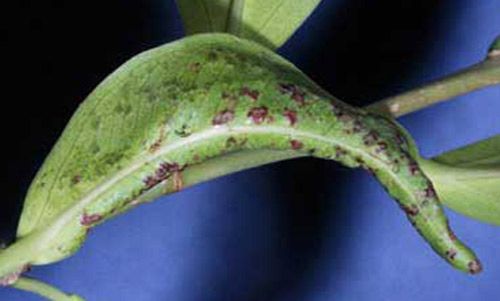
Credit: Paul M. Choate, UF/IFAS
Some exotic Ficus species are listed as invasive in Florida. Bennett (1995) suggested that Gynaikothrips potentially may serve as biological control agents of these unwanted invaders. Refer to Mound (2013) for more information on thrips and galls, including leaf-gall thrips of Ficus.
Management
Pest status, the intensity of management, and the types of tactics differ in landscape and commercial production. Considerable injury is generally tolerable on landscape plantings of Ficus whereas detectable populations or plant injury on nursery plants is generally intolerable.
Biological Control
Montandoniola confusa Streito and Matocq (Hemiptera: Anthocoridae) is the most widespread and important natural enemy in the southeastern US. It was found in Florida in 1990 (Dobbs and Boyd 2006), and incorrectly identified as Montandoniola moraguesi (Bennett 1995; Pluot-Sigwalt et al. 2009). The arrival of this species originally from the Philippines appears to be completely serendipitous. It is a very effective predator of Gynaikothrips, reducing populations more than 95%, and leaf galls by 77% (Arthurs et al. 2011); therefore, relying on this natural enemy as a biological control is the best option in the landscape. The native anthocorid Orius insidiosus (Say) is an excellent predator of many species of thrips, but it is not effective in reducing the Gynaikothrips in the leafgalls. Another thrips described from India, Androthrips ramachandrai Karny (Thysanoptera: Phlaeothripidae), has become established in the Americas, from the United States to Argentina. This thrips inhabits the leaf-galls and is an effective predator of Gynaikothrips (de Melo et al. 2013). Refer to Boyd and Held (2006) and de Borbon and Agostini (2011) for more information on Androthrips ramachandrai.
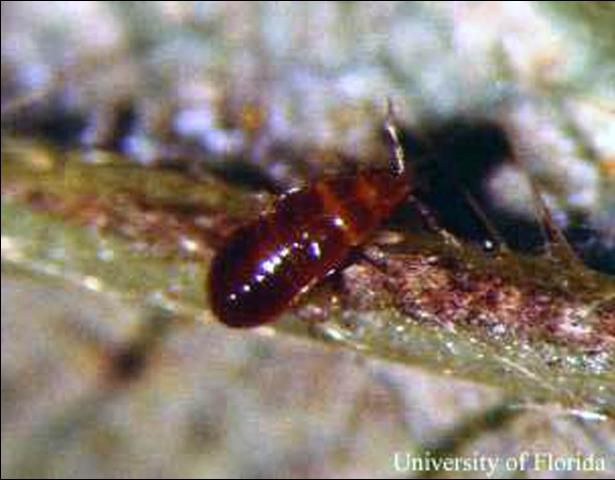
Credit: James F. Price, UF/IFAS
Other potential biological controls include green lacewing larvae, bigeyed bugs, damsel bugs, ladybird beetles, parasitic wasps, predatory mites, and Verticillium (a fungal pathogen) (Padrick 2004; Held et al. 2005; Dobbs and Boyd 2006).
Adult and immature of Montandoniola moraguesi (Puton), a predator of the Cuban laurel thrips, Gynaikothrips ficorum (Marchal), shown here with an alternate host Gynaikothrips uzeli (Zimmerman 1900).
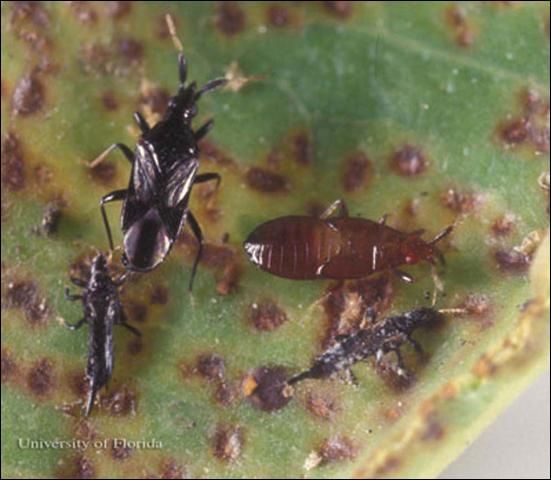
Credit: L. J. Buss, UF/IFAS
Cultural Control
Replacing Ficus microcarpa and Ficus benjamina with a resistant species of Ficus probably would be the best and most lasting control of this pest. Because both species only attack the tender new foliage, the new growth can be pruned to remove injured leaves and to suppress the thrips population.
Chemical Control
Insecticides are available that are effective against Gynaikothrips on Ficus (Held and Boyd 2008b). Systemic insecticides provide better control of thrips in galls. Broad-spectrum insecticides are detrimental to natural enemies that have the potential to naturally maintain populations of Gynaikothrips at relatively low numbers in the landscape (Arthurs et al. 2011). Insecticides are frequently the only option in nurseries considering the very low level of injury that is acceptable in domestic and international markets. University of Florida trials have shown that soil drench with certain systemic insecticides is effective, whereas foliar applications are not. Contact your county extension office for specific insecticide recommendations.
Selected References
Arthurs S, Chen J, Dogramaci M, Ali AD, Mannion C. 2011. Evaluation of Montandoniola confusa Streito and Matocq sp. nov. and Orius insidiosus Say (Heteroptera: Anthocoridae), for control of Gynaikothrips uzeli Zimmerman (Thysanoptera: Phlaeothripidae) on Ficus benjamina. Biological Control 57: 202–207.
Bennett FD. 1995. Montandoniola moraguesi (Hemiptera: Anthocoridae), a new immigrant to Florida: Friend or Foe? Vedalia 2: 3–6.
Boyd DW, Held DW. 2006. Androthrips ramachandria (Thysanoptera: Phlaeothripidae): an introduced thrips in the United States. Florida Entomologist 89: 455–458.
Cabrera-Asencio L, Ramirez A, Saez L, Velez AL. 2008. Gynaikothrips uzeli Zimmerman (Thysanoptera: Phlaeothripidae) y Montandoniola moraguezi Puton (Hemiptera: Anthocoridae): Nuevos records para Puerto Rico. Journal of Agriculture of the University of Puerto Rico 92: 111–113.
Canizo JD. 1945. Redescripción de Gynaikothrips ficorum (Marchal) concepto actual del género Gynaikothrips Zimmerman, neuvo para la fauna continental europea (Thysanoptera, Phlaeothripidae). Eos. 21: 123–156.
de Borbon CM, Agostini JP. 2011. Karny (Thysanoptera, Phlaeothripidae), first records for Argentina (Zimmermann) and Karny (Thysanoptera, Phlaeothripidae), first records for ArgentinaKarny (Thysanoptera, Phlaeothripidae), first records for Argentina. Revista de la Facultad de Ciencias Agrarias, Universidad Nacional de Cuyo 43 (1): 253-260. (17 March 2014)
de Melo FS, Cavalleri A, de Souza Mendonca, Jr M. 2013. Predation of Gynaikothrips uzeli (Thysanoptera: Phlaeothripidae) by Androthrips ramachandrai (Thysanoptera: Phlaeothripidae). Florida Entomologist 96: 859–863.
Denmark HA. 1967. Cuban laurel thrips, Gynaikothrips ficorum, in Florida. Florida Department of Agriculture. Entomology Circular 59, 1–2.
Dobbs TT, Boyd DW. 2006. Status and distribution of Montandoniola moraguesi (Hemiptera: Anthocoridae) in the continental United States. Florida Entomologist 89: 41–46.
Held DW, Boyd D. 2008a. New records of Gynaikothrips uzeli (Zimmerman) (Thysanoptera: Phlaeothripidae) on Ficus benjamina in Texas and O'ahu, Hawaii. USA. Pan-Pacific Entomologist 84: 77–80.
Held DW, Boyd D. 2008b. Evaluation of sticky traps and insecticides to prevent gall induction by Gynaikothrips uzeli (Zimmerman) (Thysanoptera: Phlaeothripidae) on Ficus benjamina. Pest Management Science 64: 133–140.
Held DW, Boyd D, Lockley T, Edwards GB. 2005. Gynaikothrips uzeli (Thysanoptera: Phlaeothripidae) in the southeastern United States: distribution and review of biology. Florida Entomologist 88: 538–540.
Hoddle MS, Mound LA, Paris DL. 2012. Thrips of California. CBIT Publishing, Queensland. (24 May 2022)
Marchal P. 1908. Sur une nouvelle espèce de thrips (Thysanopt.) nuisible aux Ficus en Algérie. Bulletin de la Société Entomologique de France No. 14: 251–253.
Mound LA. 2013. Thrips and galls. CSIRO Ecosystem Services, Canberra, Australia. (24 May 2022)
Mound LA, Wang C-L, Okajima S. 1996. Observations in Taiwan on the identity of the Cuban laurel thrips (Thysanoptera, Phlaeothripidae). Journal of the New York Entomological Society 103: 185–190.
Nixon P, et al. (1999). Orchid pests and their management. Home, Yard & Garden Pest Newsletter. Available at http://hyg.ipm.illinois.edu/pastpest/199919a.html [accessed 24 May 2022].
Padrick RC. 2004. Tips for Cuban laurel thrips. Ornamental Outlook 12(7): 40.
Pluot-Sigwalt D, Streito JC, Matocq A. 2009. Is Montandoniola moraguesi (Puton, 1896) a mixture of different species? (Hemiptera: Heteroptera: Anthocoridae). Zootaxa 2208: 25–43.
Priesner H. 1939. Zur Kenntnis der Gattung Gynaikothrips Zimm. (Thysanoptera). Mitteilungen der Muenchner Entomologischen Gesellschaft 29: 475–487.
Watson JR. 1923. Synopsis and catalog of the Thysanoptera of North America. University of Florida Agricultural Experiment Station Bulletin 168: 100 p.
Wolcott GN. 1953. Control of the laurel thrips, Gynaikothrips ficorum (Marchal). Journal of Agriculture of the University of Puerto Rico 37: 234–240.